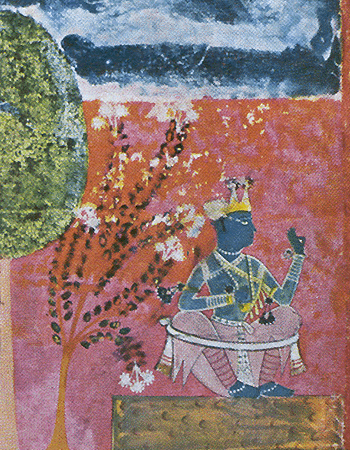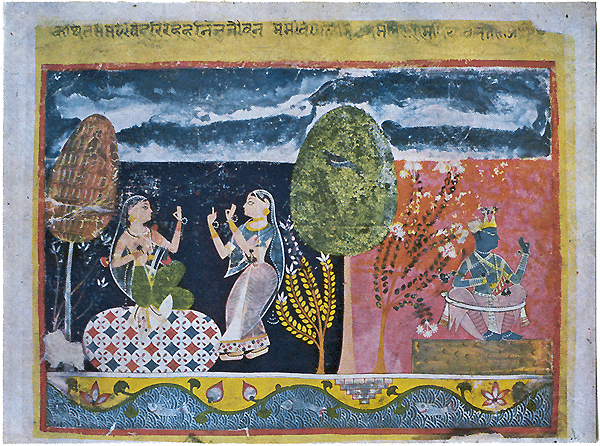Gita Govinda #16
BY: SUN STAFF

Nov 26, USA (SUN) — This month-long series explores text and manuscript illustrations from Gita-Govinda
Having reached the end of the text manuscripts and illustrations in Jaur Gita-Govinda, we will now look at a series of other Gita-Govinda manuscripts of note. Some of these are very directly related to the Jaur Gita-Govinda, and allow an excellent comparative study to be made.
The following painting is one of two Gita-Govinda illustrations dated at approximately 1575 A.D., the same era as the set in the Caurapancasika style on display at the Prince of Wales Museum. Along with the second illustration, which will be featured in tomorrow's edition of this Sun series, these two images are invaluable for comparison with the Jaur I>Gita-Govinda, as they reflect a totally different pictorial treatment of the theme and verbal content of the very same text verses.
In the seventh sarga, the sakhi returns alone without Krsna. Radha, striken with grief, weeps and cries aloud, 'who will be my solace, my youth, my love is wasted.' The stylistic differences are self-evident and hardly need comment. The format, the figure drawing, the spatial arrangement, the dress and coiffure, the trees and the foliage are all different. The only element which holds the two together is the poetic verse which is renderd pictorially.

The painter of the Jaur Gita-Govinda is less sophisticated, but appears to be more sensitive. He recreates the verbal imagery through a series of contrasts. The painting above, classified as one amongst the Caurapancasika, has a more formal, sophisticated and intellectual approach. This painter's composition is formally divided into the sky above, the stylized Yamuna below, with the two scenes of Radha and sakhi in one section, and Krsna sitting solitary in another.
The three-fourths face, the extended eye, and the pastel shades of the Jaur Gita-Govinda are replaced here by an unambiguous profile transparent odhanis and chakadara jama. Even if the provenance is debatable, can one deduce that one style led to the other, or vice versa, on the basis of the dates suggested and the clear colophon of the Jaur Gita-Govinda? Clearly the answer would be no.
The same negative conclusion would be reached if the Jaur Gita-Govinda illustrations are compared with the illustrations of the Prince of Wales Museum Gita-Govinda. The only conclusion one can arrive at is that in the last quarter of the sixteenth century, during the time of Sri Caitanya Mahaprabhu's manifest lila, there were multiple regional schools in evidence. Consequently, it would be erroneous to establish a unilinear chronology of development for each of the schools. This deduction could be supported through a comparative study of the several regional dramatic and musical forms of the contemporary period. If this hypothesis is not accepted, then one would be obliged to place the entire Caurapancasika group of paintings much later than the dates so far ascribed to them.
It would appear that the Jaur Gita-Govinda is obviously the last in the line of the painting schools called the Western Indian school. The school apparently continued until the end of the sixteenth century before giving way to the early Mewar paintings. Elsewhere, as in the Prince of Wales Museum Gita-Govinda in the Caurapancasika style, along with the above image and the one to be featured tomorrow, a more formal and sophisticated style of painting had emerged wherein the format, figure drawings and palette had all changed.
The Jaur Gita-Govinda remains unaffected by these changes, although it develops its own individual style. The antecedents of the style obviously have to be traced to the Western Indian paintings on the Jaina and Vaisnava themes.

